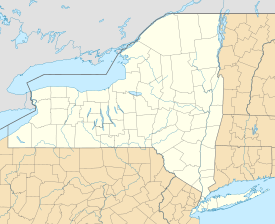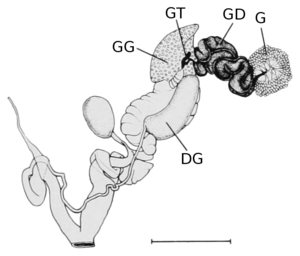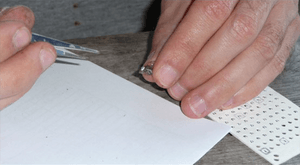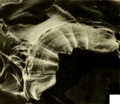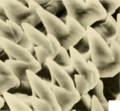Chittenango ovate amber snail facts for kids
Quick facts for kids Chittengo ovate amber snail |
|
|---|---|
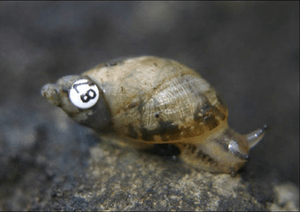 |
|
| Right side view of Novisuccinea chittenangoensis. The snail is marked with a number for monitoring the population. | |
| Conservation status | |
| Scientific classification | |
| Kingdom: | |
| Phylum: | |
| Class: | |
| (unranked): |
clade Heterobranchia
clade Euthyneura clade Panpulmonata clade Eupulmonata clade Stylommatophora clade Elasmognatha |
| Superfamily: |
Succineoidea
|
| Family: |
Succineidae
|
| Subfamily: |
Succineinae
|
| Genus: |
Novisuccinea
|
| Species: |
N. chittenangoensis
|
| Binomial name | |
| Novisuccinea chittenangoensis (Pilsbry, 1908)
|
|
| Synonyms | |
|
|
The Chittenango ovate amber snail, with the scientific name Novisuccinea chittenangoensis, is a small, air-breathing land snail. It belongs to the family Succineidae, known as the amber snails. This special snail was first found in 1905.
A few years later, in 1908, it was thought to be a type of another snail, the oval ambersnail. But after many studies, scientists realized it was its own unique species. They looked at its body shape and even its chemistry to figure this out.
The Chittenango ovate amber snail lives only in the Chittenango area of Madison County, New York, in the United States. There is only one known group of these snails left. They live at Chittenango Falls State Park in central New York. Some scientists think these snails might have lived in more places long ago, based on old fossils. But others say it's hard to tell for sure from fossils because the shells of these snails all look very similar.
Contents
What Does It Look Like?
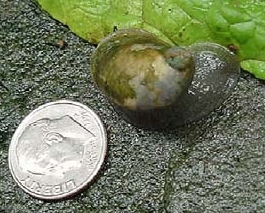
The Novisuccinea chittenangoensis is a small snail. Adults are about 20.9 millimeters (less than an inch) long. Its shell is delicate and shaped like an oval. It has about three and a quarter whorls, which are the turns of the shell.
The shell is almost clear, like glass. It can be a pale yellow or white color and has a shiny surface. You can sometimes see some of the snail's insides through its shell! The soft parts of the snail's body are a pale, see-through yellow. They might have different markings as the snail grows.
Baby snails, called hatchlings, are only 1 to 2 millimeters long. Young snails, called yearlings, grow to about 10 millimeters.
Where Does It Live?
The only place where the Chittenango ovate amber snail lives today is at Chittenango Falls. This is in Chittenango Falls State Park, New York. Scientists have looked in many other places that seem like good homes for the snail. But they haven't found any other groups of Novisuccinea chittenangoensis outside of this park.
The snails live in a deep ravine at the bottom of the 167-foot-tall waterfall. This area stays cool and often shady, even in summer. This creates a special microclimate that the snails need. The constant water flow from the falls also keeps the area moist.
Sometimes, heavy rains or melting snow can wash away plants in the snail's home. But the area grows back. The snails are mostly found on the east side of the falls, on a ledge. They also live on a middle ledge above the main one and in the rocky slopes below.
What Conditions Does It Need?
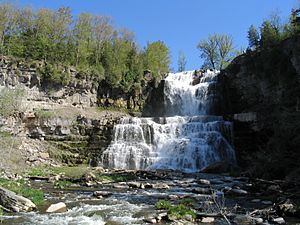
Five important things help the Chittenango ovate amber snail choose its home:
- Humidity: These snails need very high humidity, almost 100 percent. They are most active when the air is super moist. When it's dry, they become inactive.
- Substrate: The snails need a rocky ground that has lots of calcium carbonate. This comes from rocks like limestone.
- Temperature: They like cool, mild temperatures, usually between 12 and 20 degrees Celsius (54-68 degrees Fahrenheit). The mist from the waterfall helps keep the area cool. In winter, they hide in rock cracks to stay warm.
- Vegetation: The snails live among mosses and other low plants in the waterfall's spray zone. They are often found on green plants.
- Water Quality: While they are land snails, clean water is likely important for their habitat. However, scientists are still studying how water quality directly affects them.
How Does It Live?
Scientists have been studying the life of the Chittenango ovate amber snail more recently. They've learned about how it lives, what it eats, and how it reproduces.
Life Cycle
The snails mate from May to July. They lay their eggs from June to July. These snails are hermaphroditic, meaning each snail has both male and female parts. It's not clear if they can fertilize themselves.
Each egg cluster has about 8 to 14 eggs. The eggs are clear and about 2 millimeters wide. The snails lay their eggs at the bottom of plants, under matted plants, or in wet soil. The baby snails hatch in 2 to 3 weeks. They are very tiny, only about 2 millimeters long.
Scientists think the snails become adults in five to eight months. They live for about 2.5 years.
What Do They Eat?
The Chittenango ovate amber snail is an herbivore, meaning it eats plants. They seem to eat tiny plants, called microflora. They also need to get a lot of calcium carbonate from their environment. This helps their shells grow strong.
Who Are Their Predators?
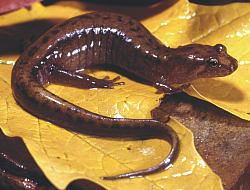
Some animals that might eat these snails include beetles and certain fly larvae. Salamanders, like the Allegheny Mountain dusky salamander, are also common in the snail's habitat and might eat them. Small mammals and birds, such as robins, are also seen near where the snails live.
Even other snails might sometimes eat them. Right now, it doesn't seem like predators are the biggest problem for the snail's survival. But for a small or struggling group of snails, any predation could be serious.
How Many Are Left?
It's hard to know exactly how many Chittenango ovate amber snails there are. When they were first found in 1905, people said there were "great abundance" of them. But later surveys found fewer and fewer. In 1972, one scientist thought there were less than 200 snails.
In recent years, scientists have used special methods, like marking and recapturing snails, to get better estimates. In 2002, they estimated about 183 snails. In 2004, the estimate was higher, around 680 snails. Scientists continue to monitor the population.
There have also been attempts to raise these snails in zoos, called "captive populations." The Rosamond Gifford Zoo in Syracuse, New York, tried to keep a group of them. But sadly, the last snails there died in 2002. More research is needed to figure out how to keep them healthy in captivity.
Why Is It Endangered?
The Chittenango ovate amber snail was first suggested to be an endangered species in 1976. This was because its numbers seemed to be going down, and it lived in such a small area. In 1978, it was listed as a threatened species. This was because people thought there might be another group of them in Tennessee and North Carolina.
However, it was later found that those snails were not the same species. So, the Chittenango Falls group remains the only known population. In New York State, it is listed as an endangered species.
Many people visit Chittenango Falls State Park each year. In the past, visitors often walked through the snail's habitat. This human disturbance was a big threat. But now, fences have been put up to protect the snail's home.
Scientists are working to help the snail survive. They want to keep the wild population at Chittenango Falls healthy. They are also trying new ways to create and keep captive populations. This would help protect the species from disappearing completely.
Images for kids
-
The type specimens of Novisuccinea chittenangoensis in the Philadelphia Academy of Natural Sciences, collected by the American malacologist Leslie Raymond Hubricht
-
Lateral and marginal teeth of radula
-
U.S. Fish and Wildlife Service, New York State Department of Environmental Conservation, and other partners regularly survey the Chittenango Falls for Novisuccinea chittenangoensis.
See also
 In Spanish: Succinea chittenangoensis para niños
In Spanish: Succinea chittenangoensis para niños



